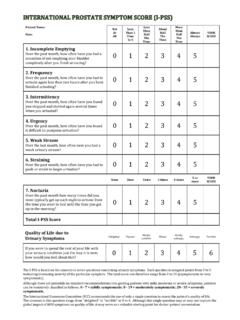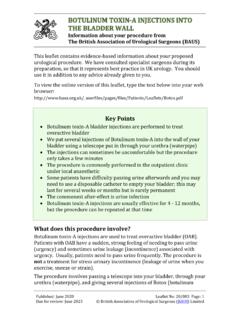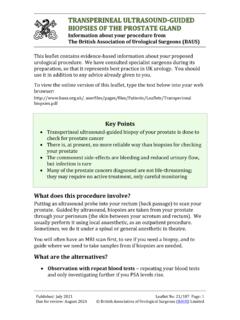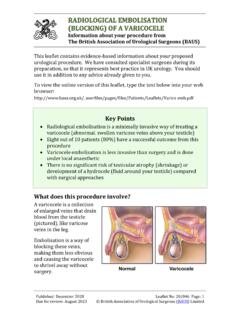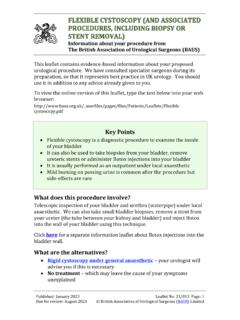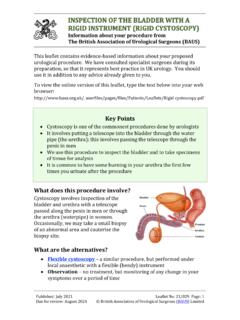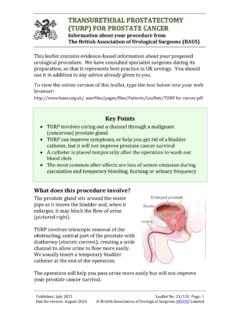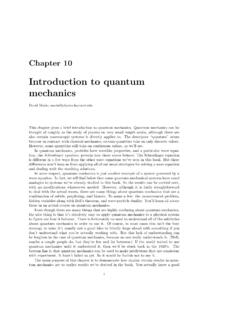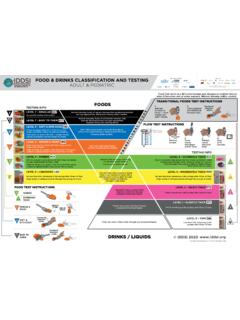Transcription of Information about your procedure from The British ...
1 Information about your procedure from The British Association of Urological Surgeons (BAUS) Published: December 2020 Leaflet No: 20/129 Page: 1 Due for review: August 2023 British Association of Urological Surgeons (BAUS) Limited This leaflet contains evidence-based Information about your proposed urological procedure . We have consulted specialist surgeons during its preparation, so that it represents best practice in UK urology. You should use it in addition to any advice already given to you. To view the online version of this leaflet, type the text below into your web browser: What does this procedure involve?
2 The procedure involves removal of your testicle, through a groin incision, for suspected testicular cancer. Removal of the entire testicle allows full examination of the growth, and accurate assessment of a possible cancer, whereas a small biopsy of the growth may miss, or underestimate, a cancer. Testicular cancer and its treatments (especially chemotherapy) can affect fertility. You will, therefore, be given the opportunity to produce semen samples for storage. These can be used in the future for assisted conception if your fertility does not recover after treatment. Key Points Radical removal of the testicle is usually performed for suspected testicular cancer Taking small biopsies of a growth in a testicle may miss a cancer, whereas complete removal allows an accurate assessment of any suspicious area Removal of the testis may be all that is required if cancer is found, but chemotherapy or radiotherapy are sometimes needed Testicular cancer and its treatment can affect your fertility, so you should bank your sperm before treatment A testicular prosthesis (implant) can be put in at the time of your operation, if you wish Published.
3 December 2020 Leaflet No: 20/129 Page: 2 Due for review: August 2023 British Association of Urological Surgeons (BAUS) Limited Sperm storage must be done before any treatment which may affect your fertility ( chemotherapy). It is best done before your operation because, if there is no sperm present in your ejaculation, some can be extracted from your testicle at the time of surgery. We can put in a testicular prosthesis (implant), if you wish, at the same time as your testicle is removed. What are the alternatives? There are, in effect, no alternatives to this procedure but, in very selected cases, the surgeon may feel partial removal of the testis is an option.
4 What happens on the day of the procedure ? Your urologist (or a member of their team) will briefly review your history and medications, and will discuss the surgery again with you to confirm your consent, and confirm the side of the testicle being removed. An anaesthetist will see you to discuss the options of a general anaesthetic or spinal anaesthetic. The anaesthetist will also discuss pain relief after the procedure with you. We may provide you with a pair of TED stockings to wear, and give you a heparin injection to thin your blood. These help to prevent blood clots from developing and passing into your lungs.
5 Your medical team will decide whether you need to continue these after you go home. Details of the procedure we normally carry out the procedure under a general anaesthetic we may give you an injection of antibiotics into a vein, after a careful check for allergies we remove your testicle through an incision in your groin (pictured, after full healing) we may also take biopsies from the other testicle but this will be discussed with you before the procedure if you wish to have a prosthesis (implant) inserted, we normally do this through the same incision it may not be appropriate to put in an implant if there has been a lot of bleeding or any difficulty during the operation (because of the Published: December 2020 Leaflet No: 20/129 Page: 3 Due for review: August 2023 British Association of Urological Surgeons (BAUS) Limited increased risk of infection); in this case, a prosthesis can be implanted later in a second procedure .
6 We close your wound with absorbable stitches which do not require removal, and normally disappear within two to three weeks Are there any after-effects? The possible after-effects and your risk of getting them are shown below. Some are self-limiting or reversible, but others are not. We have listed some very rare after-effects (occurring in less than 1 in 250 patients) individually. The impact of these after-effects can vary a lot from patient to patient; you should ask your surgeon s advice about the risks and their impact on you as an individual: After-effect Risk Swelling and bruising of your scrotum Almost all patients Dissatisfaction with the final cosmetic result (if a testicular prosthesis has been put in) 1 in 5 patients (20%)
7 The implant may lie at a higher level and be a slightly different size and consistency from the other testicle Between 1 in 2 & 1 in 10 patients Feeling the fixation stitch for the implant through your scrotal skin Between 1 in 2 & 1 in 10 patients Testicular cancer, if found, may not be cured by removal of the testicle alone Between 1 in 10 & 1 in 50 patients Additional procedures including radiation, chemotherapy, and even further surgery, may be needed Between 1 in 10 & 1 in 50 patients Permission to biopsy the other testicle at the time of surgery, especially if it is small or looks abnormal on ultrasound Between 1 in 10 & 1 in 50 patients Published: December 2020 Leaflet No: 20/129 Page: 4 Due for review: August 2023 British Association of Urological Surgeons (BAUS) Limited What is my risk of a hospital-acquired infection?
8 Your risk of getting an infection in hospital is between 4 this includes getting MRSA or a Clostridium difficile bowel infection. This figure is higher if you are in a high-risk group of patients such as patients who have had: long-term drainage tubes ( catheters); bladder removal; long hospital stays; or multiple hospital admissions. What can I expect when I get home? you will get some swelling and bruising of the scrotum which may last several days The pathology tests on your testicle may not show any evidence of cancer Between 1 in 10 & 1 in 50 patients Infection of the incision requiring further treatment (and possible removal of the testicular prosthesis) Between 1 in 10 & 1 in 50 patients As a result of the surgery and any further treatment ( chemotherapy)
9 , you may lose your fertility Between 1 in 10 & 1 in 50 patients Dissatisfaction with the final cosmetic result, with or without a testicular implant Between 1 in 10 & 1 in 50 patients Pain, infection, bleeding or leakage of the implant requiring further treatment Between 1 in 50 & 1 in 250 patients Unknown long-term risks from the use of silicone products Between 1 in 50 & 1 in 250 patients Anaesthetic or cardiovascular problems possibly requiring intensive care (including chest infection, pulmonary embolus, stroke, deep vein thrombosis, heart attack and death) Less than 1 in 250 patients (your anaesthetist can estimate your individual risk) Published: December 2020 Leaflet No: 20/129 Page: 5 Due for review.
10 August 2023 British Association of Urological Surgeons (BAUS) Limited you may be uncomfortable at first, but simple painkillers such as paracetamol should help this you may be given a scrotal support, unless you have had a testicular prosthesis inserted you should avoid heavy lifting and strenuous exercise for at least a month your stitches are absorbable and usually disappear afer two to three weeks you will be given advice about your recovery at home you will be given a copy of your discharge summary and a copy will also be sent to your GP any antibiotics or other tablets you may need will be arranged & dispensed from the hospital pharmacy a follow-up appointment will be made for you to attend the clinic within two weeks of the procedure .
